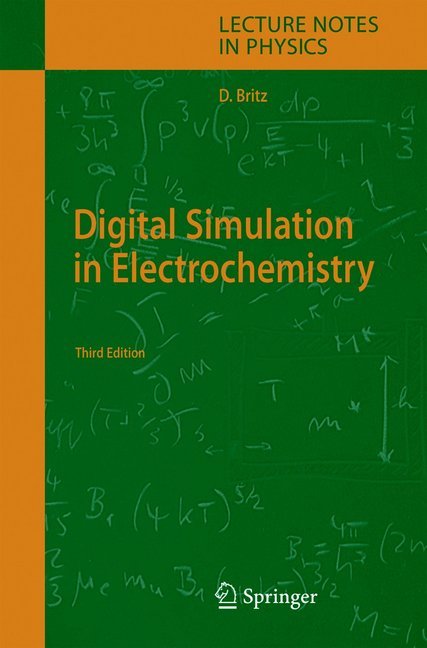Current Distributions and Electrode Shape Changes in Electrochemical Systems
Current Distributions and Electrode Shape Changes in Electrochemical Systems
In plating, electrochemical surface finishing, elec trochemical reactors as well as in electrochemical energy conversion, there is an increasing demand for high speed and high efficiency processes. These ob jectives are largely influenced by cell design. The study of such systems requires, besides know-how, a perfect scientific insight into the interaction bet ween electrode kinetics, cell geometry and mass and charge transport. Needless to say, for that purpose, computer modelling has gained rapidly in importance over the last few years. Indeed, up to the 1960's, only problems with rather simple geometries and amenable to analytical techni ques were treated. In 1964, Klingert et al. [60], as well as Fleck et al. [42] outlined the first computer programs for calculating current distributions by the finite dif ference method. F~ve years later, Riggs et al. [94J presented the first electrode shape change simulations. They used also the finite difference method. In 1978, Bergh [ 12J applied at first the - nite element method to predict electrode shape changes. Since then, an increasing number of publi cations on-computer modelling of electrochemical sys tems, appeared. Mainly the finite difference or the finite element method were used.
1.2. The electrode-electrolyte interphase
1.3. Transport equations in dilute solutions
1.4. Solution of the transport equations in dilute solutions
1.5. The boundary conditions of the potential model
1.6. Types of current distributions
1.7. The Wagner number
1.8. Electrode shape change
1.9. Conclusion
2. Solution of the Potential Model
2.1. Introduction
2.2. Hypotheses and definitions
2.3. Weighted residual statements for the Laplace equation
2.4. Solution of current distributions with trial functions satisfying the field equations
2.5. Solution of current distributions with trial functions not satisfying the field equations
2.6. Solution of current distributions based on weight functions satisfying the field equation
2.7. The physical interpretation of the integral equation
2.8. The outer normal convention.
2.9. Indirect and regular boundary methods
2.10. Comparison of the treated weighted residual methods
2.11. Solution of current distributions by electric simulation
2.12. Conclusion
3. The Boundary Element Method to Solve Current Distributions
3.1. Introduction
3.2. Concretization of the boundary element method
3.3. The overvoltage equations
3.4. Solution of the non-linear system of equations
3.5. Examples
3.6. Copper electrorefining: numerical and experimental results
3.7. Conclusion
4. Electrode Shape Change
4.1. Introduction
4.2. The discretization with respect to time
4.3. The electrode shape change algorithm
4.4. Examples
4.5. Electrodeposition and electrode dissolution in copper electrorefining. Numerical and experimental results
4.6. Conclusion
5. General Conclusion
References
Appendices
A.1.1 Primary current distribution along a free cathode in parallel with an anode and perpendicular to an insulating boundary
A.1.2 Primary current distribution along an L-shaped cathode
A.1.3 Primary current distribution along a cathode being in line with an insulating boundary
A.2 Solution of the potential model using trial functions satisfying the field equation: example
A.3.1 Analytic integration of integrals involved by the two-dimensional boundary element method using straight elements
A.3.2 Evaluation of integrals involved by the boundary element method used to solve axisymmetric potential problems
A.4 The global Newton convergence of the potential problem with non-linear boundary conditions.
1. The Current Distribution in Electro-Chemical Systems
1.1. Introduction1.2. The electrode-electrolyte interphase
1.3. Transport equations in dilute solutions
1.4. Solution of the transport equations in dilute solutions
1.5. The boundary conditions of the potential model
1.6. Types of current distributions
1.7. The Wagner number
1.8. Electrode shape change
1.9. Conclusion
2. Solution of the Potential Model
2.1. Introduction
2.2. Hypotheses and definitions
2.3. Weighted residual statements for the Laplace equation
2.4. Solution of current distributions with trial functions satisfying the field equations
2.5. Solution of current distributions with trial functions not satisfying the field equations
2.6. Solution of current distributions based on weight functions satisfying the field equation
2.7. The physical interpretation of the integral equation
2.8. The outer normal convention.
2.9. Indirect and regular boundary methods
2.10. Comparison of the treated weighted residual methods
2.11. Solution of current distributions by electric simulation
2.12. Conclusion
3. The Boundary Element Method to Solve Current Distributions
3.1. Introduction
3.2. Concretization of the boundary element method
3.3. The overvoltage equations
3.4. Solution of the non-linear system of equations
3.5. Examples
3.6. Copper electrorefining: numerical and experimental results
3.7. Conclusion
4. Electrode Shape Change
4.1. Introduction
4.2. The discretization with respect to time
4.3. The electrode shape change algorithm
4.4. Examples
4.5. Electrodeposition and electrode dissolution in copper electrorefining. Numerical and experimental results
4.6. Conclusion
5. General Conclusion
References
Appendices
A.1.1 Primary current distribution along a free cathode in parallel with an anode and perpendicular to an insulating boundary
A.1.2 Primary current distribution along an L-shaped cathode
A.1.3 Primary current distribution along a cathode being in line with an insulating boundary
A.2 Solution of the potential model using trial functions satisfying the field equation: example
A.3.1 Analytic integration of integrals involved by the two-dimensional boundary element method using straight elements
A.3.2 Evaluation of integrals involved by the boundary element method used to solve axisymmetric potential problems
A.4 The global Newton convergence of the potential problem with non-linear boundary conditions.
Deconinck, Johan
| ISBN | 978-3-540-55104-1 |
|---|---|
| Artikelnummer | 9783540551041 |
| Medientyp | Buch |
| Copyrightjahr | 1992 |
| Verlag | Springer, Berlin |
| Umfang | XV, 281 Seiten |
| Abbildungen | XV, 281 p. 8 illus. |
| Sprache | Englisch |








